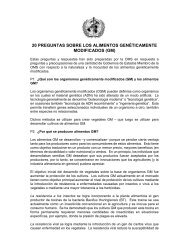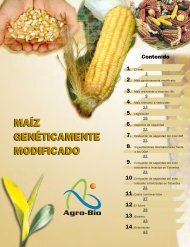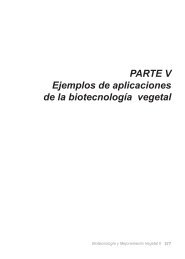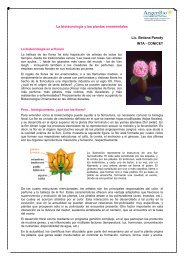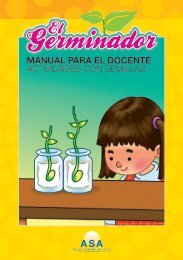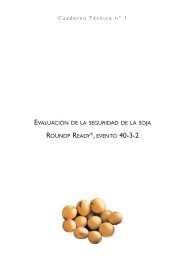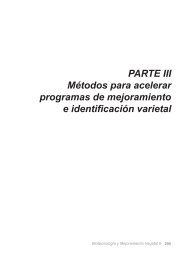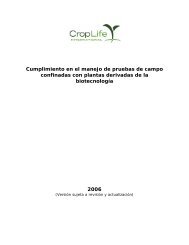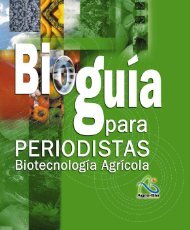New Genetics, Food and Agriculture: Scientific ... - ArgenBio
New Genetics, Food and Agriculture: Scientific ... - ArgenBio
New Genetics, Food and Agriculture: Scientific ... - ArgenBio
You also want an ePaper? Increase the reach of your titles
YUMPU automatically turns print PDFs into web optimized ePapers that Google loves.
34N E W G E N E T I C S, F O O D A N D A G R I C U LT U R Ea p p ro p r i ate, soc i o - e conomic co n s i d e rations. Baseline datare q ui red for env i ro n m e n tal impact as s es s m e n t, includinginformation on native species <strong>and</strong> existence of sexually compatiblewild relatives of agricultural crop plants are limited incentres of crop diversity (OECD 2001b).Ecol og i cal expe r i m e n tati o n : In ecol og i cal impact as s es s-ments, it is difficult to extrapolate from small-scale field trialsto co m m e rc i a l - s cale cu l tivation. Co un tr i es have ta ken anumber of approaches to dealing with this issue. In the UK,the approach has been to hold far m - s cale field trials th ata d d ress scale, <strong>and</strong> inte grate regional cu l tivation pra c ti ces<strong>and</strong> farmer be h av i o ural issues. The cost of th ese issuetargetedfarm-scale field trials may be prohibitive for routineas s essments of impacts of indiv i dual LMOs. Re g u l ato ryrequirements may impose a cost barrier for development ofminor crops or those important in the developing world.Towards Coexistence of DifferentAgricultural SystemsOne of the future challenges is devising ways <strong>and</strong> means,including stan d ard s, for diffe rent forms of agr i cu l ture to beable to live together in areas of multiple l<strong>and</strong> use. This is particularlychallenging for farmers practising broad scale agricul ture an d /or org anic agr i cu l ture. For exam ple, res e arc hcommissioned by the EC over the past 15 years is giving guidance to ways to minimize gene fl ow from crop to crop an dfrom crops to wide relatives (Eastham <strong>and</strong> Sweet, EEA 2001).Different crop species have different rates of autogamy (selfpoll i n ation) <strong>and</strong> out - c rossing. In addition, some crops havehybridising wild relatives in Europe while others do not. Thecharacteristics of the main crop types crops when cultivatedin Europe are summarized in Table 5.3.Un i n tended gene fl ow can be minimized by spatial an dte m po ral bar r i e rs (with gui d an ce as to the neces s ary distance be tween crops); by selecting crops with low risks ofgene flow outside the crop, either because they are not outcrossingspecies, or there are no related or wild species in thevicinity; <strong>and</strong>/or by targeting gene expression to certain partsof plants (e.g. leaves) <strong>and</strong> having no target gene expression inpollen.Risks of RegulationReg u l ation can itself be a risk <strong>and</strong> a be n efit for new tec h n ologydev elopment. The products of modern geneti cs in agr i cu l-ture are re g u l ated more str i n g e n tly th an their co un te r par t scoming from tra d i tional breeding programs or the products ofo ther produ c tion sys tems such as org anic agr i cu l ture.The cost, complexity <strong>and</strong> uncertainty of regulation in newgenetics is making regulatory requirements one of the barriersto entry for public research institutes, poor countries <strong>and</strong>small companies. This has long been the case in the pharmaceutical<strong>and</strong> agrochemical sector. It is becoming the case inthe seed sector as well. This is increasing the trend for futurei nves tments to co n ce n trate on those products with like l ycommercial value where the costs of regulation will be builtinto the price of the product. Less investment will be availablefor generating public goods, including those of possible valuein emerging eco n o m i es. Biosafe ty re g u l ato ry re q ui re m e n t sare limiting the choices for the use of new geneti cs toimprove agriculture in emerging economies.However, there remains a lack of public confidence in there g u l ato ry sys tems in some co un tr i es <strong>and</strong> this is one of th ed r ive rs behind the incre asing str i n g e n cy of re g u l ation. Thisrai s es the issue of wh at more needs to be done to improvepublic confidence in the regulatory <strong>and</strong> post-approval stagesof the re l e ase of geneti cally mod i fied org anisms into th eenvironment.Further science-based case studies that compare the risks,be n e fits <strong>and</strong> re g u l ation of crops deve l o ped th rough newg e n e tic te c h n ol og i es with similar crops cu l tivated un d e ri n te n s ive agr i cu l tural pra c ti ces an d /or org anic agr i cu l tura lp ra c ti ces, would be us e ful to illus trate the re l ative merits ofdifferent approaches <strong>and</strong> various scenarios.International Harmonization of RegulationsSe tting stan d ards <strong>and</strong> reg u l ato ry har m o n i zation: T h eFAO/WHO spo n s o red inte rg ove r n m e n tal co m m i s s i o n ,Codex Al i m e n tar i us, is pl aying an impo r tant role in setti n gi n te r n ationally agreed gui d e l i n es <strong>and</strong> stan d ards for th esafety of genetically modified foods for human consumption



